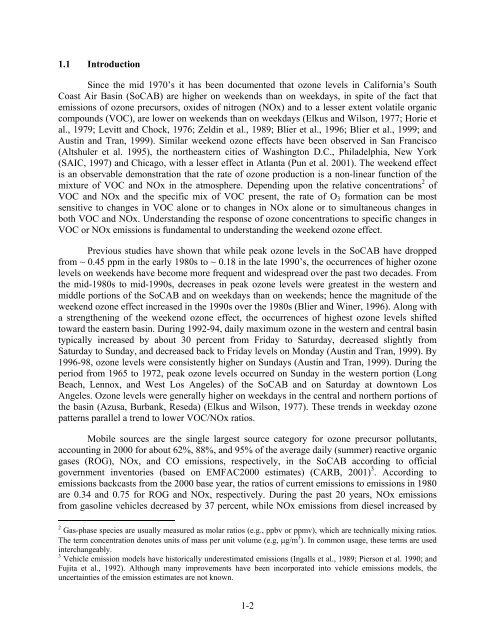Weekend/Weekday Ozone Observations in the South Coast Air Basin
Weekend/Weekday Ozone Observations in the South Coast Air Basin
Weekend/Weekday Ozone Observations in the South Coast Air Basin
Create successful ePaper yourself
Turn your PDF publications into a flip-book with our unique Google optimized e-Paper software.
1.1 Introduction<br />
S<strong>in</strong>ce <strong>the</strong> mid 1970’s it has been documented that ozone levels <strong>in</strong> California’s <strong>South</strong><br />
<strong>Coast</strong> <strong>Air</strong> Bas<strong>in</strong> (SoCAB) are higher on weekends than on weekdays, <strong>in</strong> spite of <strong>the</strong> fact that<br />
emissions of ozone precursors, oxides of nitrogen (NOx) and to a lesser extent volatile organic<br />
compounds (VOC), are lower on weekends than on weekdays (Elkus and Wilson, 1977; Horie et<br />
al., 1979; Levitt and Chock, 1976; Zeld<strong>in</strong> et al., 1989; Blier et al., 1996; Blier et al., 1999; and<br />
Aust<strong>in</strong> and Tran, 1999). Similar weekend ozone effects have been observed <strong>in</strong> San Francisco<br />
(Altshuler et al. 1995), <strong>the</strong> nor<strong>the</strong>astern cities of Wash<strong>in</strong>gton D.C., Philadelphia, New York<br />
(SAIC, 1997) and Chicago, with a lesser effect <strong>in</strong> Atlanta (Pun et al. 2001). The weekend effect<br />
is an observable demonstration that <strong>the</strong> rate of ozone production is a non-l<strong>in</strong>ear function of <strong>the</strong><br />
mixture of VOC and NOx <strong>in</strong> <strong>the</strong> atmosphere. Depend<strong>in</strong>g upon <strong>the</strong> relative concentrations 2 of<br />
VOC and NOx and <strong>the</strong> specific mix of VOC present, <strong>the</strong> rate of O 3 formation can be most<br />
sensitive to changes <strong>in</strong> VOC alone or to changes <strong>in</strong> NOx alone or to simultaneous changes <strong>in</strong><br />
both VOC and NOx. Understand<strong>in</strong>g <strong>the</strong> response of ozone concentrations to specific changes <strong>in</strong><br />
VOC or NOx emissions is fundamental to understand<strong>in</strong>g <strong>the</strong> weekend ozone effect.<br />
Previous studies have shown that while peak ozone levels <strong>in</strong> <strong>the</strong> SoCAB have dropped<br />
from ~ 0.45 ppm <strong>in</strong> <strong>the</strong> early 1980s to ~ 0.18 <strong>in</strong> <strong>the</strong> late 1990’s, <strong>the</strong> occurrences of higher ozone<br />
levels on weekends have become more frequent and widespread over <strong>the</strong> past two decades. From<br />
<strong>the</strong> mid-1980s to mid-1990s, decreases <strong>in</strong> peak ozone levels were greatest <strong>in</strong> <strong>the</strong> western and<br />
middle portions of <strong>the</strong> SoCAB and on weekdays than on weekends; hence <strong>the</strong> magnitude of <strong>the</strong><br />
weekend ozone effect <strong>in</strong>creased <strong>in</strong> <strong>the</strong> 1990s over <strong>the</strong> 1980s (Blier and W<strong>in</strong>er, 1996). Along with<br />
a streng<strong>the</strong>n<strong>in</strong>g of <strong>the</strong> weekend ozone effect, <strong>the</strong> occurrences of highest ozone levels shifted<br />
toward <strong>the</strong> eastern bas<strong>in</strong>. Dur<strong>in</strong>g 1992-94, daily maximum ozone <strong>in</strong> <strong>the</strong> western and central bas<strong>in</strong><br />
typically <strong>in</strong>creased by about 30 percent from Friday to Saturday, decreased slightly from<br />
Saturday to Sunday, and decreased back to Friday levels on Monday (Aust<strong>in</strong> and Tran, 1999). By<br />
1996-98, ozone levels were consistently higher on Sundays (Aust<strong>in</strong> and Tran, 1999). Dur<strong>in</strong>g <strong>the</strong><br />
period from 1965 to 1972, peak ozone levels occurred on Sunday <strong>in</strong> <strong>the</strong> western portion (Long<br />
Beach, Lennox, and West Los Angeles) of <strong>the</strong> SoCAB and on Saturday at downtown Los<br />
Angeles. <strong>Ozone</strong> levels were generally higher on weekdays <strong>in</strong> <strong>the</strong> central and nor<strong>the</strong>rn portions of<br />
<strong>the</strong> bas<strong>in</strong> (Azusa, Burbank, Reseda) (Elkus and Wilson, 1977). These trends <strong>in</strong> weekday ozone<br />
patterns parallel a trend to lower VOC/NOx ratios.<br />
Mobile sources are <strong>the</strong> s<strong>in</strong>gle largest source category for ozone precursor pollutants,<br />
account<strong>in</strong>g <strong>in</strong> 2000 for about 62%, 88%, and 95% of <strong>the</strong> average daily (summer) reactive organic<br />
gases (ROG), NOx, and CO emissions, respectively, <strong>in</strong> <strong>the</strong> SoCAB accord<strong>in</strong>g to official<br />
government <strong>in</strong>ventories (based on EMFAC2000 estimates) (CARB, 2001) 3 . Accord<strong>in</strong>g to<br />
emissions backcasts from <strong>the</strong> 2000 base year, <strong>the</strong> ratios of current emissions to emissions <strong>in</strong> 1980<br />
are 0.34 and 0.75 for ROG and NOx, respectively. Dur<strong>in</strong>g <strong>the</strong> past 20 years, NOx emissions<br />
from gasol<strong>in</strong>e vehicles decreased by 37 percent, while NOx emissions from diesel <strong>in</strong>creased by<br />
2 Gas-phase species are usually measured as molar ratios (e.g., ppbv or ppmv), which are technically mix<strong>in</strong>g ratios.<br />
The term concentration denotes units of mass per unit volume (e.g, µg/m 3 ). In common usage, <strong>the</strong>se terms are used<br />
<strong>in</strong>terchangeably.<br />
3 Vehicle emission models have historically underestimated emissions (Ingalls et al., 1989; Pierson et al. 1990; and<br />
Fujita et al., 1992). Although many improvements have been <strong>in</strong>corporated <strong>in</strong>to vehicle emissions models, <strong>the</strong><br />
uncerta<strong>in</strong>ties of <strong>the</strong> emission estimates are not known.<br />
1-2
















